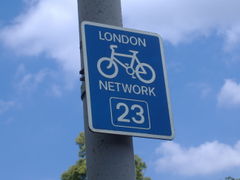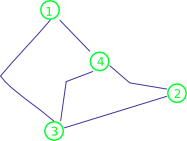Cycle routes

|
| Description |
| Bicycle and cycleway features |
| Tags |
Cycle routes or bicycle route are named or numbered or otherwise signed routes. May go along roads, trails or dedicated cycle paths.
Tagging cycle route networks
Four levels of hierarchy are currently in use: international, national, regional, and local. Routes may be marked by tagging each way according to the following table. For an alternative using relations that will also be rendered on the cycle map, see Relations/Routes#Cycle routes (also mountain bike).
It is often better to use relations to tag cycle routes rather than the tags in this table (see below for the relation tagging scheme). But please check that a relation doesn't already exist before creating one.
| Tag | Element | Description |
|---|---|---|
icn=yes |
Designates that a road or path is part of an International Cycling Network route. | |
ncn=yes |
Designates that a road or path is part of a National Cycling Network route. | |
ncn=proposed |
Designates that a road or path is part of a proposed National Cycling Network route. | |
rcn=yes / proposed |
As above, but for regional cycle routes. | |
lcn=yes / proposed |
As above, but for local cycle routes. | |
icn_ref=number |
A international cycle route, where number is the route number. icn=yes is implied
| |
ncn_ref=number |
A national cycle route, where number is the route number. ncn=yes is implied
| |
rcn_ref=number |
A regional cycle route, where number is the route number. rcn=yes is implied
| |
lcn_ref=number |
A local cycle route, where number is the route number. lcn=yes is implied
|
route=ncn was previously used, but is currently deprecated due to clashing with other routes that may share the same way.
Tagging cycle junction networks

Cycle junction networks (for example look here) are common in the Netherlands, Belgium and Germany, but not in the UK. In contrast to the standard cycle route networks, where the path has a reference number, in a cycle node network the junctions are numbered. Signs along the way indicate the junction you are heading towards, so a given path will have a sign pointing in one direction indicating "1" and in the other direction indicating "4".
We use the same tags, but apply the reference numbers to the junction nodes. The same principles could in principle be used for international, national and local cycle junction networks, but currently regional is mainly use in Belgium and the Netherlands.
| Tag | Element | Description |
|---|---|---|
rcn=yes |
Designates that a junction node is part of a regional cycle junction network. It is often better to use relations for | |
rcn_ref=number oricn_ref=number orncn_ref=number orlcn_ref=number
|
Designates that the node represents a numbered junction in the regional (or international, national or local) cycle node network. |
Please refer to the pages below for national or regional specific details:
An expanded way of tagging cycle node networks, which is currently already being employed in parts of Belgium and The Netherlands, is described at Cycle Node Network Tagging.
Relations
It is preferred to tag the cycle routes using relations instead of tagging the ways. But please check that a relation doesn't already exist for your chosen route before creating one. Links to country-specific overview pages of cycle networks are below. Additionally, search existing relations in the database (Helpful tools below).
The tags on the relation are slightly modified from the standard tags. An example cycle route relation would have the following tags:
| Tag | Comment |
|---|---|
type=route
| |
route=bicycle/mtb |
See mountainbike for details on tagging mountainbike routes. |
network=icn/ncn/rcn/lcn |
Specify the network as an international route, a national route, a regional route, or a local route, as per the normal tagging of cycle routes. For tagging mountainbike routes more specific look here mountainbike |
cycle_network=* |
(optional) In countries that have (for instance) multiple regional route networks, this tag indicates the specific route system, much the way network=* does on road route relations.
|
ref=number |
(optional) Numerical part of reference code of the route. (This formal limit was introduced originally to cater for a certain renderer, so using the full code should be fine too, as long as it can be read from signs along the route.) The network or cycle_network tag already distinguishes the type, so just use "ref" and not "ncn_ref" or similar. |
name=* |
(optional) The name of the route e.g. Jubilee Cycle Way |
state=proposed |
(optional) Routes are sometimes not official routes pending some negotiation or development -- the opencyclemap rendering shows these routes dotted. |
distance=distance in km |
(optional) The distance covered by a route in km |
ascent=ascent in m |
(optional) The ascent covered by a route in meters. If a route has start and end point at different altitude use descent too |
descent=descent in m |
(optional) The descent covered by a route in meters. Use it only if it differs from the ascent (different altitude at start/endpoint of a route). |
roundtrip=yes/no |
(optional) Use roundtrip=no to indicate that a route goes from A to B. Use roundtrip=yes to indicate that the start and finish of the route are at the same location (circular route). |
colour=* |
(optional) To indicate the official colour associated with a route. In the Waymarked Trails cycling map, the displayed ref/name of a route gets underlined in this colour (example). |
Relation role: Cycle routes sometimes have different paths depending on the direction you are travelling. In this case, ways in the relation should have a role of forward or backward as described in Relation:route#Members. The direction is rendered on the cycle map (example).
Mountainbike routes
- See Mountainbiketours for cycle routes that are primarily for mountainbikes.
- Additionally, have a look at the Mountainbike portal for tagging guidelines to ways suitable for mountainbiking.
Rendered cycle maps
Rendered maps use tiles to display the data. They can be used on any device which can display images on screen. The basic approaches are web services are web services (tiles stored on a server, internet connection necessary to view) or offline services (download all tiles first and then store them on the device).
- CyclOSM
- Free bicycle world map with cycle routes and much more.
- OpenCycleMap
- This is an online map with cycle tracks, contours, and bike services highlighted. The tiles are licenced as CC-BY-SA 2.0 and mass use requires an API key (cost depending on usage plan).[1]
- Waymarked trails: cycling
- Waymarked trails is a online overlay over standard tile layer showing cycle routes. The overlay is licensed as CC-BY-SA 3.0 Germany and mass download is strongly discouraged.[2]
- extract.bbbike.org
- Bbbike offers an extract service to download tiles and data in various formats. There is also a professional version available using an API key (fee required).[3]
- cycle.travel map
- A web map with also allows routing. An API access needs individual arrangement[4], no dedicated licensing applies.
- Cyclestreets' photomap
- The photomap is a web map based on OpenCycleMap but enriched with photos. Uploaders can choose a licence for their files. There are API keys and commercial arrangements are available, too.[5][6]
- Wireless Bikemap
- A web map focused on biking infrastructure and amenities.
- VeloPlanner
- A route oriented map with some route unrelated POIs
- Traili Map
- Bike map for bicycle tourists
Even though not specifically for bicyclists, the web maps https://opentopomap.org and https://www.wanderreitkarte.de/ might be useful as well.
Usage
Since the tagging is generic, it is up to each country to decide how to map the cycle networks that exist in their country onto the hierarchy of national/regional/local.
Transnational
EuroVelo
The EuroVelo (wikipedia) network consists of 13 routes, with a total distance of 72,978 km, developed by the European Cyclists' Federation. The route references are in the format EVxy, e.g. EV12 for the North Sea Cycle Route.
See the European Wikiproject EuroVelo for further details.
Greenways
The Greenways project aims to build an international network of bicycle and other non-motorized trails focussed on Eastern European countries. The motivation is to provide local people and visitors with access to natural and cultural heritage areas.
See the European Wikiproject Greenways for further details.
Australia
See Australian Tagging Guidelines/Cycling and Foot Paths
Austria
See: Austria/Radwege
Belgium
See the Belgian cycle route conventions and their project page for full details.
Baltic States: Lithuania, Latvia, Estonia
The project BaltiCCycle.eu collects all information on cycling in the Baltic States (BaltiCCycle.eu_Routes)including the International Routes EuroVelo, R1, Iron Curtain Trail, the National Cycling Routes in Estonia (EstoVelo)
Canada
- Canada#Trans Canada Trail
- Fr:Route verte (Québec)
Czechia
Denmark
See: Da:Bicycle/Network-Routes
France
See: France/Itinéraires cyclables
Finland
See: Fi:Valtakunnalliset pyörämatkailureitit
Germany
See DE:Bicycle/Fahrradroutensammlungen for overview of German cycle route collections.
Hungary
See Hungary/Kerékpárút for overview of Hungarian cycle route collections.
Iceland
See WikiProject Iceland/Cycleways for an overview of Icelandic cycle routes and ways.
Ireland
See WikiProject Ireland/Cycling for an overview of Irish cycle routes, ways and other bicycle infrastructure.
Italy
See Italy/Ciclovie for an overview of Italian cycle route collections.
Luxembourg
See WikiProject Luxembourg/Cycle Route Network for an overview of Luxembourgish cycle route network (Pistes cyclables).
Netherlands
Zie: Fietsroutes.
Norway
See Norway/Sykkelruter i Norge.
Slovakia
See Slovak Cycling Routes for full details.
Spain
See Spanish Cycling Network for full details.
Sweden
See Swedish Cycling Network for full details.
Switzerland
See Swiss Cycle Network and Swiss Mountain Bike Network for full details.
United Kingdom
Note: CycleStreets is a major user of cycling-related data in the UK area. Information on its interpretation of tags may be of interest (and the developers strongly welcome feedback on this).
CycleStreets has produced a fully-designed and downloadable 'Get mapping' guide, with particular focus on adding data for improving bicycle routing.
| Network | Tagging | Example |
|---|---|---|
| Sustrans' National Cycle Network National routes (red numbers). See Cycling in the United Kingdom for a list and to see if a relation has already been set up. References shouldn't be given a prefix i.e. use 54 and not N54. Remember to map the mileposts too - see Sustrans Millennium Mileposts. | Add to an existing relation or create a new relation or use ncn=*, ncn_ref=* |

|
| Sustrans' National Cycle Network Regional routes (blue numbers). See Cycling in the United Kingdom too for a list and to see if a relation has already been set up. References shouldn't be given a prefix i.e. use 47 and not R47. | Add to an existing relation or create a new relation or use rcn=*, rcn_ref=* |
 (Sign showing both national and regional spur). |
| Transport for London's (TfL) network of Cycleways, including existing Cycle Superhighways and Quietways. | rcn=*, rcn_ref=* |
|
| Greater London's older network, London Cycle Network (LCN). See London Cycle Network. | lcn=*, lcn_ref=* |

|
| Ipswich, other towns etc. local cycle networks | lcn=*, lcn_ref=*
| |
| The National Byway | network=rcn See National Byway. |

|
| The Pennine Bridleway, a 209 km route parallel to the Pennine Way hiking trail | ||
| The Scottish Borders region has several signed long distance routes: the Border Loop (402 km), North Sea Cycle Route, Southern Borders Loop, 4 Abbeys Cycle route, Tweed Cycleway. There is also a signed local network depicted by coloured circles | Border Loop 149461 4 Abbeys 3159944 Tweed cycleway 3160049 |

|
United States
See United States/Bicycle Networks and United States Bicycle Route System for full details.
Helpful tools
- OSM Relation Analyzer (for searching existing route relations)
Related pages
- Bicycle tags map - a slippy map that renders cycling related OSM tags
- Cheltenham Standard - a 2008-2009 discussion of how to tag the suitability for cycles of all-purpose roads
- Cycle_routes/cyclability
amenity=bicycle_parkingamenity=bicycle_rentalshop=bicyclevending=bicycle_tubebarrier=cycle_barrierreference=*- motor vehicle routescrossing=*cycle_network=*- United States Bicycle Route System
- WikiProject Europe/EuroVelo